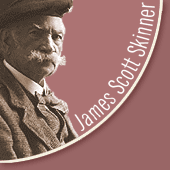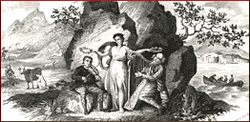




Background
Other Composers and Compilers
The University of Aberdeen has a fine collection of Scottish music dating back to the beginning of the eighteenth century. Some of this music is in manuscript form, some in printed collections. The manuscript collections are a mixture of newly composed tunes and old tunes – to provide material for the compiler to play.
Distinctions are not often clear between the different types of melody in these early collections of Scottish dance music. What to us is clearly a strathspey, with its jerky, dotted rhythms, might be called a reel. What to us is a reel, with a constant, even rhythm, is sometimes called a jig. In the eighteenth century in particular, the names for different types of dance music were interchangeable.
We have chosen selections from some of these collections, to give you an idea of what Scottish music was like in the century before Skinner’s birth. They give a flavour of how the music has developed over the past three hundred years. We have also provided musical examples from some of Skinner’s contemporaries. These composers and collectors either included Skinner’s music in their own collections or he included their music in The Harp and Claymore Collection.
The Collections:
You can look at examples from:
- William C Honeyman’s The Violin: How to Master It (JSS0295 – JSS0301), includes a diagram, which shows the player how to stand, and illustrates the correct hand position. (JSS0295). In Chapter IX (JSS0296 – JSS0301), Honeyman discusses and analyses Strathspeys. He felt that Scottish music ‘defies all rule’, as in its quirky construction, it breaks the rules of conventional harmony.
- Correspondence between William Walker and P J Anderson. P J Anderson was the librarian at King’s College Library, University of Aberdeen in the first decades of the twentieth century. They discuss the Christie Family of Monquhitter’s musical collections. (JSS0505 – JSS0519)
- William Christie Collection. William Christie (c.1778 – 1849), from Cuminestown in Aberdeenshire, was a dancing master and fiddler. He composed and collected tunes. This compilation, published in 1820, includes what may have been the first printed version of the popular north east Scotland song, ‘Oh Gin I Were Where Gadie Rins’ (JSS0522). (JSS0520 – JSS0528)
- Daniel Dow (1732-1783), fiddler and composer from Perthshire. ‘Thirty seven New Reels and Strathspeys’ has one of the first ever uses of the word ‘Strathspey’ to appear in a title. Published around 1776, Dow’s book preceded Niel Gow’s first publication. (JSS0529 – JSS0530)
 Captain Simon Fraser of Knockie, Inverness-shire
(1773 – 1862)
collected and composed some beautiful melodies, mainly in the Gaelic
idiom. Fraser had to apply for funding to help him to publish his music.(JSS0531 – JSS0536)
Captain Simon Fraser of Knockie, Inverness-shire
(1773 – 1862)
collected and composed some beautiful melodies, mainly in the Gaelic
idiom. Fraser had to apply for funding to help him to publish his music.(JSS0531 – JSS0536)- James Christie’s manuscript was compiled between 1730 and 1760. The family tradition was that Christie’s grandfather had written out the music. The melodies in this collection include ‘O’er the Bogie’ (JSS0539), which is one of the earliest tunes known to be from north east Scotland. The song, ‘The Flowers of the Forest, (JSS0540) may date back to 1513, the year of the Battle of Flodden, with which it is associated. (JSS0537 – JSS0540)
- James Webster’s unpublished collection of dance music dates to 1836. Webster lived in New Deer, Aberdeenshire. This collection consists of music for quadrilles and music for country dances set to Spanish music. There are also instructions for performing the country dances. When Webster compiled his collection, quadrilles, which had come from France around thirty years previously, were very popular. Webster, who may have been a dancing master, used Scottish melodies for the quadrilles. (JSS0541 – JSS0545)
- Catharine Jean Moir’s hand-written collection was started on January 1st 1790 in Fyvie, Aberdeenshire. As she was learning to play the harpsichord, the examples used here show carefully written out rudiments of music. (JSS0546 – JSS0548)
- David Glen’s Collection of Ancient Piobaireachd or Highland Bagpipe Music was published in 1880. Glen came from a family of bagpipe makers. He included some of Skinner’s pipe tunes. We have included a very old piobaireachd, ‘Mackintosh’s Lament’ which apparently dates from 1526. We have also included an example of a bagpipe fingering chart. (JSS0549 – JSS0551)
- William McGibbon (c.1690 – 1756), a violinist and composer, was based in Edinburgh. A Collection of Scots Tunes some with a bass for a violoncello or harpsichord, includes a version of ‘The Tindars Occupation’ (JSS0555), otherwise known by the name ‘Clout the Cauldron’, which Skinner included in The Harp and Claymore Collection. For this, see JSS0192, JSS0193, JSS0194. (JSS0552 – JSS0555)
- The Misses White of Brockly, also composed and collected music. They wrote a Strathspey in honour of Captain Simon Fraser of Knockie. (JSS0556 – JSS0557)
- The Italian composer Urbani, published a series of volumes of Scottish music arranged for violin and cello. We give an example at JSS0558
- Francis Peacock (1723 – 1807), was not only a respected dancing master in Aberdeen, he was also a founder member of the Aberdeen Musical Society (JSS0651 – JSS07662). In 1762, he published a collection of ‘Fifty Favourite Scotch Airs’ arranged for flute, violin, cello and harpsichord. The melody ‘Bushaboon Traquair’ (JSS0562) was later used by Skinner for Figure 4 of his Ettrick Vale Quadrilles. For Skinner’s version, see JSS0670. (JSS0559 – JSS0563)
- John Niven’s hand written collection of melodies was compiled in 1762. The collection comprises 70 pages and 227 tunes. Niven lived in Aberdeen, in what is now Provost Skene’s house. He had been imprisoned with his father as a result of the Jacobite rebellion. His collection includes rudiments for learning to read music. (JSS0564 – JSS0568)
- Nathaniel Gow (1763 – 1831), was the son of the famous fiddler, Niel Gow. Unfortunately, Nathaniel did not always attribute melodies to their composers, which led many to consider him ‘unscrupulous’. Nevertheless, he was a respected musician, a publisher, a teacher and composer. Skinner included Nathaniel’s famous ‘Largo’s Fairy Dance’ (JSS0643) in The Harp and Claymore. We have included some examples from Gow’s Complete Repository, including his own addition to the melody, ‘The Pic Nic’. (JSS0569 – JSS0573)
- William Marshall (1748 – 1833), from Fochabers, Moray, was factor to the Duke of Gordon as well as a clockmaker, violinist and composer. We have included some examples from his collection of Scottish Airs (1822). (JSS0574 – JSS0576)
- Dr Keith Norman Macdonald’s Gesto Collection came out in 1895. A large collection of Highland music, it was a great influence on Skinner, who dedicated The Harp and Claymore Collection to Macdonald (JSS0009, JSS0010). Skinner included some of the tunes that appeared in the Gesto collection in The Harp and Claymore, such as Gille Calum (JSS0120 in Harp, and JSS0344 in Gesto). (JSS0337 – JSS0344)
- The Aberdeen Musical Society was formed in 1747/8. The members intended to meet once a week ‘for their musical entertainment’. It disbanded in 1806. Although it reformed later, it never again reached the same strength. We have included its resolutions, an inventory and a subscriber’s list. (JSS0651 – JSS0662)
- The most fascinating aspect of Cruickshank’s Accordion and Flutina Teacher is its diagrams, which are detailed and interesting. A close look at these shows just how much the accordion has developed since the late nineteenth century. (JSS0502 – JSS0504)
Pat Ballantyne
